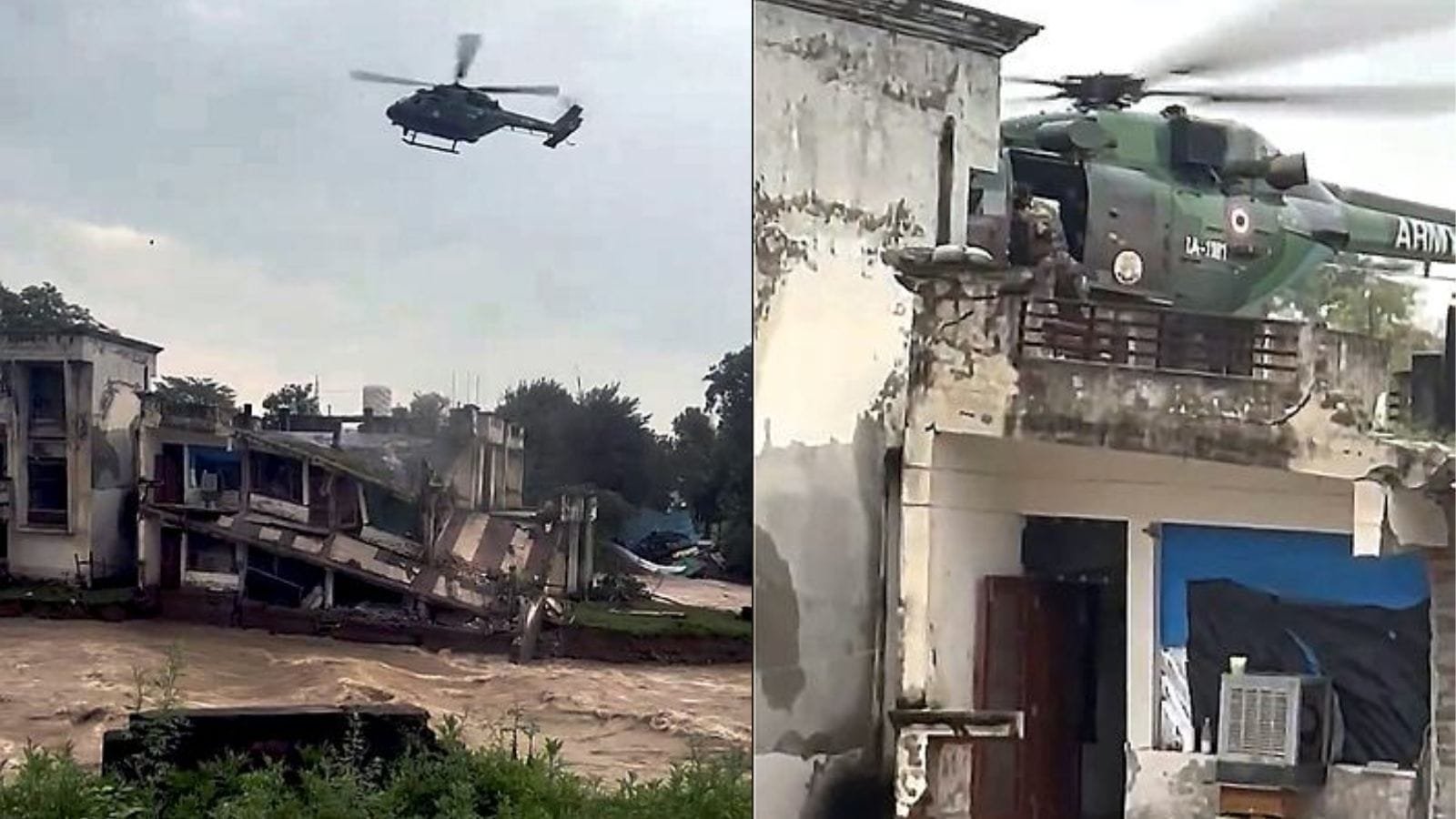As incessant rains and swollen rivers submerged many villages and low-lying areas in Punjab, massive relief and rescue operations on Tuesday were conducted in several districts with teams of various central and state agencies and the Army evacuating residents to safer places.
With the weather department predicting more rains in coming days, Chief Minister Bhagwant Mann announced closure of all schools in the state from August 27 to 30.
The flood-situation has turned grim in Punjab after the water levels in Sutlej, Beas and Ravi rivers and seasonal rivulets rose following heavy rains in their catchmPent areas in Himachal Pradesh and Jammu and Kashmir, inundating large swathes of farmland and villages along these rivers.
The release of surplus water from the Pong, Bhakra and Ranjit Sagar dams have also compounded the woes of villages in several districts of Punjab, as they fear massive crop damage.
The worst-affected villages are in Pathankot, Gurdaspur, Fazilka, Kapurthala, Tarn Taran, Ferozepur and Hoshiarpur districts. A central flood control room has been established at the Circuit House in Jalandhar to tackle any possible flood situation in Punjab and to ensure immediate relief in affected areas, said officials.
Two people lost their lives due to incessant rains and floods in the state and 44,899 hectares of area under crops in 16 districts out of total 23 has been affected. Two women have died in Barnala and Hoshiarpur due to roof collapse. The victims have been identified as Sonia (30) from Barnala and Kailasho Devi from Hoshiarpur.
The situation also worsened in Kapurthala’s Mand area, which is quite far from main land, and mainland villages in Hoshiarpur districts of Doaba region, where swollen rivers and breaches in protective embankments have led to inundation of farmland and low-lying villages. The farm land on around 15,000 acres submerged under water in both the districts. In Sultanpur itself around 10,000 acres farm land of nearly 30-35 villages including 16 of Mand area and remaining on the river bank are affected.
Story continues below this ad
In Kapurthala district, the Mand area of Sultanpur Lodhi turned grim after breaches occurred in the advance bandh, a temporary embankment raised inside the main Dhussi Bandh along the Beas River. The advance bandh, built to protect crops grown on near the dry riverbed, gave way at three locations, allowing floodwaters to submerge hundreds of acres of farmland.
Officials said nearly 30–35 villages, including Ahliwal, Ahliwal Khurd, and Baupur Karim, face threat as agricultural land has been submerged. Though the number of houses in this stretch is limited, thousands of acres of paddy are at risk.
Mand area, a low-lying island between two branches of the Beas, has been under water for weeks. The island is home to small villages that depend almost entirely on farming.
Rajya Sabha MP Sant Balbir Singh Seechewal, who is monitoring the situation, said most residents have been shifted to safer places while the administration continues to supply ration and medicines to those still inside the Mand. “Floodwater has entered deep into the riverine island but so far the mainland areas remain safe,” officials assured.
Story continues below this ad
While the main Dhussi Bandh has held, breaches in the advance bandh, located closer to the river, have exposed the vulnerability of Mand villages such as Mand Mubarakpur, which remain the first to flood whenever the Beas swells. Kuldeep Singh Sangra, General Secretary of Hadd Peedit Sanghardh Committee Punjab (Flood afffected struggle committee Punjab), said that though we are in Mand area which is close to river but one of us are sitting on river land it all our ownership land and because of the low lying area and constructing a Dhussi band outside our lands now we are trapped in frequent floods despite the normal rains many a times,” said he.
In Hoshiarpur district, the problem is compounded by heavy inflow into the Pong Dam following continuous rainfall in Himachal. Deputy Commissioner Aashika Jain said sudden gushes in the Chakki river led to breaches near Motla, Mehtabpur, and Haled Janardan villages in Mukerian. Teams from the Drainage and NREGA departments were pressed into action immediately.
Jain, who personally visited the affected sites, said medical camps, fodder, drinking water, and chlorine tablets are being supplied. Revenue teams are assessing house damage to ensure timely compensation. She added that water also entered Abdulllapur, Rada, and Fatehpur Kulla areas of Tanda after problems developed at the guide bund of the National Highway bridge. The administration, she said, is in continuous coordination with the Bhakra Beas Management Board (BBMB) and the Water Resources Department to regulate discharge from the dam.
The water level in Pong Dam reached up to 1390.76 feet on Tuesday 5:00 pm, and the inflow of water was 2,30,240 cusecs while the outflow was 79,592 cusecs.
Story continues below this ad
The Dhussi Bandh, an earthen embankment system, was built along Punjab’s three perennial rivers—Sutlej, Beas, and Ravi—besides rivulets like Chitti Bein and Kali Bein, and seasonal rivers including Ghaggar and Chaki. It also safeguards against flooding from 16 major seasonal streams across Hoshiarpur, Ropar, Mohali, and Nawanshahr.
Relief and Warnings
Both Kapurthala and Hoshiarpur administrations have kept 24-hour control rooms functional, urging residents not to venture near rivers or low-lying areas. NGOs, including the Red Cross Society and local welfare groups, are distributing ration and essential supplies.
Farmers, however, are staring at devastation, with vast paddy fields submerged for days. Officials assured that assessments are underway and affected families will be compensated.




